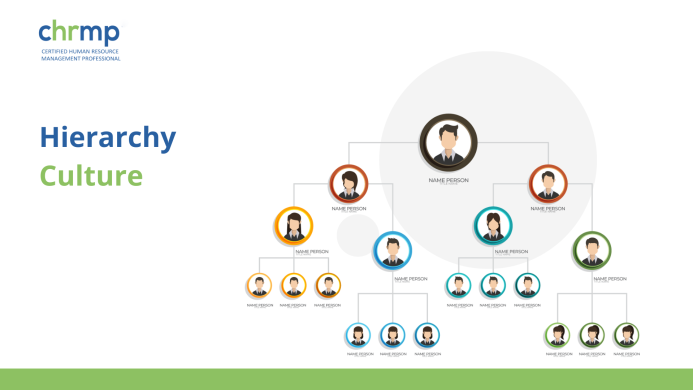

The culture of an organization can significantly influence the way we work. And one important aspect is how power and authority are structured and distributed in the company.
A hierarchy culture establishes a transparent chain of command that allows for the smooth conduction of day-to-day processes. Hierarchy structures can be observed in various organizations, including government establishments, the military, large corporations, and small businesses.
While there are several benefits of a hierarchy culture, there are drawbacks as well.
This blog will discuss the definition, characteristics, pros, and cons of hierarchical structure in organizations.
We shall also share some practical tips to incorporate the best hierarchy elements into your organization.
So without further ado, let’s get started.
Hierarchy culture in the workplace can be defined as organizing the company’s members in clearly defined levels of authority. In a hierarchical workplace culture, individuals or teams are arranged in a pyramid-like structure where the ones at the top exercise more power and authority than the ones at the bottom.
In a typical hierarchical workplace structure, the leaders/founders of the company are positioned at the top, followed by high-level managers, mid-level managers and front-line employees occupying the bottom tier.
The roles and responsibilities of each lever are set, and the top-level members make most decisions of the company, which are then passed down to the lower levels.
Hierarchy culture is important in organizations for several reasons. First and foremost, it provides a clear structure and order, establishing lines of authority and accountability. A hierarchical culture ensures that roles, responsibilities, and reporting relationships are well-defined, which promotes efficient decision-making and coordination of tasks.
Additionally, hierarchy culture establishes a framework for career progression and advancement. By delineating different levels of authority and seniority, employees have a clear path for growth and development. Hierarchy culture often includes performance-based evaluations and promotion criteria, creating a sense of motivation and ambition among employees.
Furthermore, hierarchy culture can contribute to organizational efficiency and consistency. With established reporting structures and decision-making processes, organizations can streamline operations and ensure consistent application of policies and procedures.
However, it is essential to strike a balance with the potential downsides of a hierarchical culture. Overreliance on hierarchy can lead to reduced innovation, stifled creativity, and limited employee engagement.
Here are the five key characteristics of a hierarchy culture in the workplace:
1. Clear Chain of Command:
A hierarchy culture is characterized by a transparent chain of command and defined levels of authority. In such a culture, everyone knows who they report to, and there are established protocols and procedures for making decisions.
2. Formalized Processes and Procedures:
Hierarchy culture places a high value on formalized processes and procedures, often put in place to ensure consistency and accountability. There are clear rules for how work is done, and employees are expected to follow them closely.
3. Emphasis on Status and Titles:
In a hierarchical culture, titles and status are essential. The higher someone is in the organizational hierarchy, the more power and influence they are perceived to have. Employees are expected to respect and defer to those in positions of authority.
4. Centralized Decision-Making:
In a hierarchy culture, decision-making is often centralized, with those at the top making essential decisions that are passed down to lower levels. This can lead to slower decision-making and a lack of agility, as decisions may take longer to be made and implemented.
5. Clear Separation of Roles and Responsibilities:
Hierarchy culture values a clear separation of roles and responsibilities, with each person in the organization having a specific job to do. This can create a sense of order and structure but also stifle creativity and innovation, as employees may not feel empowered to step outside their assigned roles.
Military organizations across the world are often characterized by a strong hierarchical culture. These organizations have a clear chain of command with well-defined ranks and authority structures.
Decisions and directives flow from top-level commanders down to lower-ranking officers and enlisted personnel. The hierarchical structure ensures clear lines of authority, accountability, and discipline.
The military’s hierarchical culture emphasizes following orders, strict adherence to protocols, and respect for authority.
Many large financial institutions, such as banks and investment firms, have a hierarchical culture due to the nature of their operations and regulatory requirements.
These organizations often have multiple levels of management, with clear reporting structures and well-defined roles and responsibilities.
Decision-making authority typically lies with senior executives and managers, while lower-level employees are expected to follow directives and guidelines set by their superiors.
Hierarchy is often reinforced by performance-based promotions, where individuals move up the organizational ladder based on their achievements and experience.
There are several benefits of following a hierarchical structure in the organization. Let’s take a closer look at each of the help:
1. Clear lines of authority:
A hierarchy culture provides a clear structure of authority and decision-making, which can help employees understand their roles and responsibilities and ensure that tasks are completed efficiently.
2. Consistent procedures and processes:
Hierarchy culture values formalized processes and procedures, which can create consistency and predictability in the workplace.
3. Established career paths:
In a hierarchy culture, employees may have clearly defined career paths with opportunities for training and development, which can promote employee loyalty and satisfaction.
4. Accountability: With a transparent chain of command, holding individuals accountable for their actions and decisions can be easier, improving performance and employee productivity.
While there are many benefits of following a hierarchical structure in the organization, there are also a few drawbacks.
Let’s take a look at the cons of hierarchy culture in the workplace:
1. Lack of flexibility:
The rigid nature of a hierarchy culture can stifle creativity and innovation, as employees may not feel empowered to think outside their assigned roles or challenge established protocols.
2. Slow decision-making:
With decision-making often centralized at the top of the hierarchy, the process can be slow and inefficient, making it difficult for the organization to adapt to changing circumstances.
3. Status-based culture:
In a hierarchical culture, titles and status can be highly valued, creating a work environment where employees compete for status and recognition rather than working collaboratively.
4. Communication barriers:
With clear lines of authority, communication can become restricted, making it difficult for employees to share ideas and feedback with those at higher levels of the organization.
5. Resistance to change:
A hierarchy culture can sometimes resist change, as individuals at the top may be reluctant to challenge established practices and procedures.
Here are some tips for incorporating the best elements of a hierarchy in your organization:
1. Clearly define roles and responsibilities:
Start by clearly defining the roles and responsibilities of each employee in the organization. This will help create a sense of order and structure and ensure everyone understands their place in the hierarchy.
2. Establish a clear chain of command:
Create a clear chain of command that outlines the reporting relationships within the organization. This will help employees understand who they report to and who has decision-making authority.
3. Create formalized processes and procedures:
Implement formalized processes and procedures designed to promote consistency and accountability in the workplace. This can help ensure that tasks are completed efficiently and effectively.
4. Promote communication and collaboration:
While a hierarchy culture can sometimes restrict communication, promoting open communication and collaboration within the organization is important. Encourage employees to share ideas and feedback and provide opportunities for cross-functional teams to work together.
5. Foster a culture of continuous improvement:
Finally, fostering a culture of continuous improvement within the organization is important. Encourage employees to think creatively and challenge established practices and procedures. This can help promote innovation and ensure that the organization always adapts to changing circumstances.
By incorporating these elements into your organization, you can create a culture that combines the best elements of a hierarchy culture with the flexibility and agility needed to succeed in today’s fast-paced business environment.
Overcoming the negative effects of a hierarchical culture requires a deliberate and systematic approach to foster a more inclusive and collaborative work environment. Here are five strategies that can help:
1.Encourage Open Communication:
Establish a culture of open communication where employees feel comfortable sharing their ideas, concerns, and feedback.
Encourage two-way communication channels, such as town hall meetings, suggestion boxes, or regular team meetings, to provide opportunities for employees to express their opinions and contribute to decision-making processes.
This helps break down the barriers created by hierarchy and promotes a sense of ownership and engagement among employees.
2. Empower Employees
Empowerment involves delegating decision-making authority and giving employees a greater sense of control over their work.
Provide opportunities for employees to take on more responsibilities, make decisions, and contribute to meaningful projects.
Empowerment helps foster a sense of ownership, autonomy, and accountability, reducing the negative effects of strict hierarchy and promoting a more collaborative and innovative work environment.
3. Foster Collaboration and Teamwork
Encourage collaborative work practices by promoting cross-functional teams, interdisciplinary projects, and interdepartmental cooperation.
Break down silos and encourage employees to work together, share knowledge, and collaborate on problem-solving. This helps create a more inclusive and cooperative work culture where diverse perspectives are valued and collective achievements are celebrated.
4. Provide Leadership Development
Invest in leadership development programs that equip managers and supervisors with the skills necessary to lead in a more inclusive and empowering manner.
Provide training and support for leaders to develop their emotional intelligence, communication skills, and ability to foster a positive work environment.
By developing leaders who value collaboration, transparency, and employee empowerment, the negative effects of hierarchical culture can be mitigated.
5. Foster a Learning Culture
Promote a culture of continuous learning and growth. Encourage employees to acquire new skills, pursue professional development opportunities, and share knowledge within the organization.
This helps foster a culture of learning and growth where everyone is encouraged to contribute and grow, irrespective of their position in the hierarchy.
1. What is a hierarchy culture, and how does it differ from other workplace cultures?
A hierarchy culture is a workplace culture that values clear lines of authority and decision-making. In a hierarchical culture, individuals are expected to adhere to established protocols and procedures, and decision-making is often centralized at the organisation’s top. This differs from other workplace cultures, such as a clan culture, which values collaboration and teamwork, or an adhocracy culture, which values innovation and creativity.
2. What are some of the benefits of a hierarchy culture?
A hierarchy culture’s benefits include clear lines of authority and decision-making, consistent procedures and processes, established career paths, accountability, and efficient communication.
3. What are some of the drawbacks of a hierarchy culture?
Some drawbacks of a hierarchy culture include a lack of flexibility, slow decision-making, a status-based culture, communication barriers, and resistance to change.
4. Can a hierarchy culture be combined with other workplace cultures?
Yes, combining elements of a hierarchy culture with other workplace cultures is possible. For example, an organization could incorporate the clear lines of authority and decision-making from a hierarchy culture while promoting collaboration and teamwork from a clan culture.
5. How can an organization incorporate the best elements of a hierarchy culture?
An organization can incorporate the best elements of a hierarchy culture by clearly defining roles and responsibilities, establishing a clear chain of command, creating formalized processes and procedures, promoting communication and collaboration, and fostering a culture of continuous improvement.
In conclusion, a hierarchy culture in the workplace has its benefits and drawbacks. On the one hand, it can provide structure, accountability, and efficient functioning.
On the other hand, it can also be inflexible, slow to adapt, and create a status-based culture. However, by incorporating the best elements of a hierarchy culture, such as clear lines of authority and decision-making, organizations can create a culture that promotes consistency and accountability while fostering collaboration, innovation, and flexibility.
Finding the right balance between hierarchy and other workplace cultures is key to creating a thriving organization.
© 2007-2025 CHRMP| All Rights Reserved | Powered by Ripples Learning & Research Private Limited
